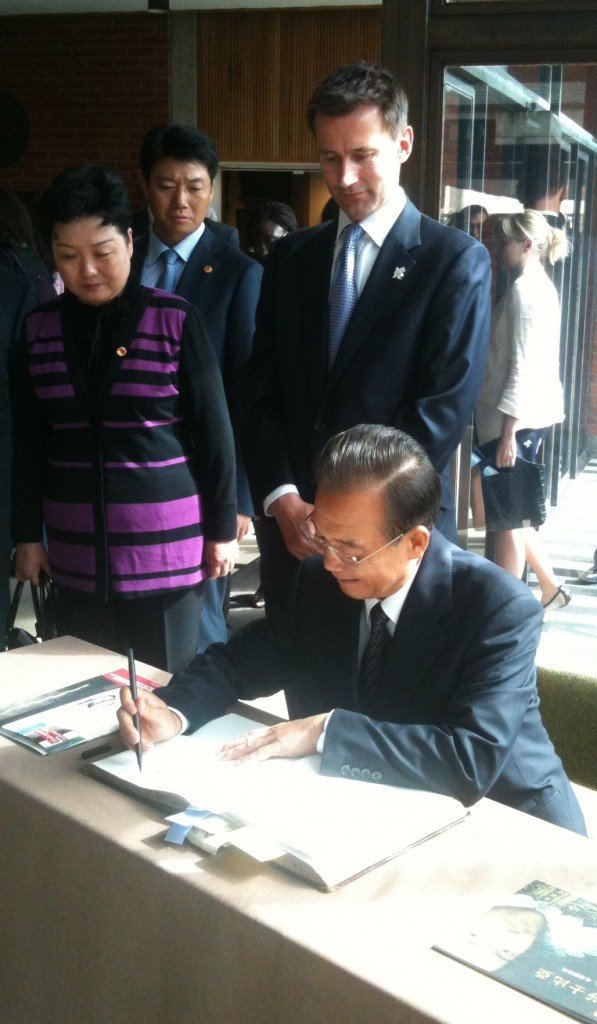This post was written by Julia Howells, PA to Diana Owen, Director of the Shakespeare Birthplace Trust.

As the Chinese Year of the Dragon approached I began to think about some of the things we learned about China and its connection with Shakespeare in the last few months. Coincidentally, it came to me that these could be considered in the context of one item in the Trust’s collection.
This three-quarter length, life-size portrait of William Shakespeare was painted by Liu Bingliang of Liaoning Province in September 2004, as part of the province’s celebration of the 440th anniversary of the dramatist’s birth. It was donated to the Shakespeare Birthplace Trust by the Liaoning Promotion Council of the World National Cultural Exchange.
We believe that Shakespeare Centre at Stratford-upon-Avon, the birthplace of Shakespeare, is the most fitting home for this piece of art. At Shakespeare Centre, the portrait from China will definitely leave visitors from all over the world a deep impression that the greatness of Shakespeare is universally acknowledged. It will bear a testimony to the fact that Shakespeare’s popularity is not merely within the UK, but could also be strongly sensed in a remote country like China.
The portrait is executed in paint on a large paper scroll with an inscription below.
But who is this Shakespeare?
Last October Diana Owen returned from a trip to China where she attended the Shanghai International Shakespeare Conference and spoke at a number of regional universities. She reported that there was great reverence of, and an enormous hunger for, Shakespeare in China - but China’s Shakespeare: a Shakespeare who embodies Oriental tradition, culture and language.

Is Bingliang’s portrait this Shakespeare? He certainly looks different to the images we regard as traditional representations of the dramatist, such as the Droeshout engraving or the Chandos portrait. This is an image of a huge man (surprisingly similar in stature to the Wain-Hobson statue in the Shakespeare Centre marble hall), theatrical and swaggering in pose and dress, with thick, flowing hair, a determined chin and dramatic dark eyes. The length of the scroll requires that it must be hung in a way that elevates the portrait above eye-level, to a more than human height.
The inscription below the portrait is well-informed, biographical information about the dramatist and some basic details about his plays. Shakespeare and other foreign writers first found popularity in China in the early twentieth century when their works were translated, and many Chinese people pride themselves on being internationally well read. Shakespeare has been taught in Chinese schools for some time; at the launch of the World Shakespeare Festival in London last September, the following mind-blowing statistics were used: approximately 50% of schoolchildren across the world, at least 64 million each year, are studying Shakespeare at school ; 65% of countries have Shakespeare as a named author on their curriculum; Chinese students (approximately 21 million each year) study The Merchant of Venice in Grade 8.
We have experienced first-hand the Chinese thirst to exchange cultural information. During 2011 the Trust welcomed eleven Chinese delegations, several of which were official cultural groups exploring how we present Shakespeare’s home and legacy. One included representatives of the National Library of China, while another came from the Cao Yu Research Council on a fact-finding visit to inform the development of a museum.
Cao Yu (1910-1996) is regarded as China’s leading twentieth century playwright. His work was greatly inspired by Shakespeare, and he did much to promote his works, including directing China’s first Shakespeare Festival in 1986. We were pleased to show the delegation items in our archive relating to Cao Yu’s visit to the Shakespeare Centre, including an album of photographs of Festival productions which he presented to the Trust.

These numerous visitors reflect both China’s intense interest in Shakespeare and a drive to promote their own rich culture on an international stage. When Premier Wen visited Shakespeare’s Birthplace in June he spoke of building international bridges through cultural understanding. Liu Bingliang’s portrait is clearly more than a response to such an understanding - it demonstrates a complete adoption and transformation.
So hail the year of the Dragon, which is characterised by excitement, unpredictability, exhilaration and intensity. I hope that you, and all the Chinese friends that we have met, have a wonderfully dramatic year.
Gōng Xǐ Fā Cái.
